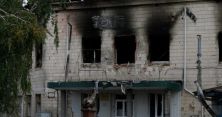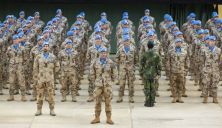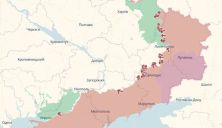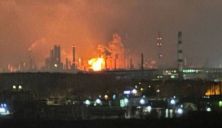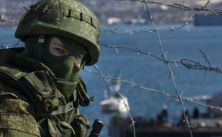Recently, the Ukrainian Center for National Resistance (CNR) published information that in the spring period, Russian occupiers intend to strengthen forced mobilization in the temporarily occupied territories (TOT) of Ukraine.
“Serious losses on the front, the Russian authorities are trying to cover with mobilization in the TOT of Ukraine, as well as by recruiting mercenaries and migrants. In this regard, the occupiers constantly exert psychological pressure on men of conscription age in order to force them to sign contracts under the threat of arrests, confiscation of movable and immovable property, or deportation from their native city to depressed regions of Russia,” — reported the CNR.
In addition, according to CNR information, Russian military commissariats are paying special attention to migrants from Central Asia who arrived at TOT in search of earnings. Currently, they are being actively involved in signing contracts with the armed forces of the Russian Federation.
According to the federal law of the occupying country “On Military Duty and Military Service,” the personnel reserve consists of mobilization human resources and a mobilization human reserve, better known as BARS — Special Combat Army Reserve. The number of the first, according to Ukrainian estimates, is from 12 to 15 million people. Representatives of BARS are significantly fewer. According to the Russian Ministry of Defense, the number of reservists is estimated at approximately 2 million people.
However, according to Russian military observer Viktor Baranets, a member of the public council under the Ministry of Defense of the Russian Federation, they are not 2 million.
“Otherwise, they would be twice the total number of the Russian army! And no partial mobilization would be needed in the country. So far, only one thing is known: in the Southern Military District, there are about 40,000 BARS members,” — he notes.
According to Ukrainian military expert Petro Chernyk, in general, Russians declare from 1.5 to 3 million people who have the appropriate military training. They have always had such a component in their army as the “conscription part.”
However, according to Russian legislation, a general mobilization can only be carried out by a presidential decree in the event of hostilities directly on the territory of Russia. Therefore, in order to continue the war against Ukraine, the authorities are conducting hidden mobilization.
And one of the ways to replenish the personnel of the occupation army is the same forced mobilization in the temporarily occupied territories of Ukraine, which the Center for National Resistance reports about.
But there are nuances.
The fact is that back in 2022, mobilization plans in the so-called “DPR” and “LPR,” according to information from open sources, reported an increase in the number of the 1st and 2nd army corps of the quasi-republics to 100,000.
Moreover, on March 19, 2022, the leader of the quasi-formation “DPR,” Pushilin, made changes to “decree” No. 30 “On Special Formations.” According to the changes made, men aged 18 to 65 years are subject to mobilization, although previously it was up to 55 years. It is reported that service will take place in the special formation “MIA DPR.”
According to the commander of the Joint Forces, Volodymyr Kravchenko, before the active phase of the Russian-Ukrainian war, the General Staff of the Russian Armed Forces formed and maintains two army corps in the occupied territories of Luhansk and Donetsk regions — the 1st (Donetsk) and the 2nd (Luhansk). Their total number is over 35,000 people. The corps are operationally subordinate to the 8th Combined Arms Army of the Southern Military District of the Russian Armed Forces.
It is easy to calculate that the number of forcibly mobilized (referring to the conscription of all men aged 18 to 65 years) is at least 50-60 thousand.
The representative of the Main Intelligence Directorate of the Ministry of Defense of Ukraine, Andrii Cherniak, in a comment to the “Donbas Realii” project, confirmed that from the beginning of 2022 until July 2023, the aggressor state Russia forcibly mobilized from 55,000 to 60,000 men into its army in the temporarily occupied territories of Ukraine.
Moreover, terrorist Russia is also driving students from temporarily occupied Ukrainian territories into the occupation army.
“A person went to classes in the morning — and two days later, they are already fighting. Essentially, Russia does not consider the residents of Donetsk and Luhansk as people, so the occupiers do not care at all, laws do not apply,” — noted Cherniak.
Currently, in the occupied territories of Luhansk region, some cities are called “women’s” by the locals themselves — due to the complete absence of the male population caused by total mobilization.
Therefore, speaking about the strengthening of forced mobilization in the temporarily occupied territories (TOT) of Ukraine, against the background of its total nature and the practical absence of the male population in the occupied territories, there is no reason.
Regarding the option of Russian mobilization at the expense of migrants from Central Asia who arrived at TOT in search of earnings. According to calculations by the analytical service of the audit and consulting network FinExpertiza, based on data from the Ministry of Internal Affairs of the Russian Federation, in 2022, 11.8 million cases of foreign workers registering for migration were recorded. According to official FSB statistics, in the first three months of 2023, 1.3 million people came to Russia for work.
In September 2022, the State Duma of the Russian Federation passed a bill that simplified the acquisition of Russian citizenship for foreigners who became contract soldiers in the Russian army. The Russian Ministry of Defense promises to pay up to 200,000 rubles per month if a contract is signed.
According to direct information from the field, the Moscow authorities have opened a recruitment point in the migration center in Sakharovo. Moreover, Russian authorities are involving labor migrants in restoring occupied Ukrainian cities and building fortifications directly on the front line.
At the end of 2024, the Russian government approved a budget for the “restoration” of the occupied territories of eastern and southern Ukraine. Over the next seven years, almost 2.3 trillion rubles (about 23 billion dollars) are planned for these purposes. Accordingly, to absorb these financial volumes, a large number of cheap labor is needed. Given that there is a shortage in Russia itself, this issue will be resolved through citizens of Tajikistan, Uzbekistan, and Kyrgyzstan.
In 2024, according to analysts from “Migrant Service,” about 1 million migrants left Russia. Mainly, citizens of Uzbekistan, Tajikistan, and Kyrgyzstan left Russia. In 2025, this trend may continue, and hypothetically, another approximately 1 million labor migrants may leave Russia in search of more attractive working conditions abroad. This could significantly impact many sectors of the Russian economy, especially those heavily dependent on migrant labor.
It is indicative that, against the backdrop of these events, in 2025, Russia increased the quota for migrants from visa-required countries by 1.5 times. The corresponding decree was signed by Prime Minister Mishustin. The quota will amount to 234.9 thousand permits.
Therefore, there is no point in paying special attention to Russian military commissariats in the occupied territories regarding migrants from Central Asia. Such measures will not contribute to attracting cheap labor but, on the contrary, will create serious problems for representatives of the occupation administrations.
Moreover, the legislation of Kyrgyzstan, Uzbekistan, and Tajikistan prohibits citizens from mercenary activities and participation in foreign armed conflicts. Since the beginning of Russia’s full-scale invasion of Ukraine, Ukrainian military forces have captured only 30 citizens of Central Asian countries who fought on Russia’s side. These figures were reported to the “News of Pryazovia” project by Ukraine’s Minister of Justice, Olha Stefanishyna.
However, in 2025, the army of the occupying country plans to recruit at least 126,000 personnel to replenish losses from among the so-called “special contingent”—prisoners, debtors, and individuals with legal issues. This refers to Russians serving sentences in prisons, under investigation, having loan debts, and other problems.
According to Ukrainian intelligence, to cover human losses on the front, Moscow plans to mobilize at least 10,000 soldiers from the “special contingent” each month. Thus, in 2025, Russia intends to mobilize at least 280,000 troops overall to replenish the losses of its units in the war against Ukraine.
It is telling that, against the backdrop of statements from official Kremlin representatives that there is currently no need for a second wave of partial mobilization, the Russian State Duma passed a law increasing the mobilization reserve by raising the maximum age for staying in the reserve. The new law raises all age limits for reserve military personnel and the mobilization reserve by 5 years. The maximum age for staying in the mobilization reserve has also been increased—to 65 years for senior officers and to 60 years for junior officers. Notably, for all other categories, the maximum age for staying in the mobilization reserve was raised immediately by 10 years—from 45 to 55 years.
According to the General Staff of the Armed Forces of Ukraine, as of February 17, the Russian army had lost approximately 859,920 soldiers in the war against Ukraine.
Military-Political Analyst Dmytro Sniehyriov
Read also: Occupiers Have Intensified in the Kupiansk Direction: Goals Analyzed by Dmytro Sniehyrov
